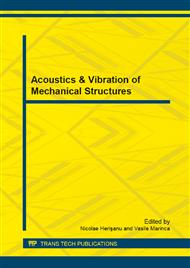p.158
p.165
p.170
p.178
p.184
p.191
p.195
p.203
p.208
Random Excitation of a Car Component from the Road
Abstract:
In the present paper aspects regarding the analytical modeling, the simulation and the experiments related to random vibrations, with applications to automotive industry, are discussed. Simplified car dynamical models based on lumped masses, springs and dampers being exposed to random vibrations, are considered. The power spectral density is used to define the excitation produced by the unevenness of the road surface which are correlated to the vehicle speed. Two different approaches are observed in parallel. The analytical one is using the dynamical model of the car, the random excitation estimation, the transfer functions from the excitation sources to the target, and the response at the comfort points or the points of interest. The associated numerical calculations are performed with Matlab. For the second approach the finite element models of the car simplified structure are created and the simulations are performed. Statistical tools are used to describe the excitation sources and the response. Good correlation of the results for the two approached is observed. In the sequel a real car component made of plastic is considered. The estimation of the component structure stress with probability of 1σ, 2σ and 3σ, are coming out from the simulation of the part subjected to random vibrations by using finite element analysis. Frequency response functions (FRF) are experimentally measured in the laboratory by placing the plastic component on a shaker. The measured FRFs and the results are compared to the ones resulted from the simulation, observing a good correlation. The output of the random vibration analysis can be used to estimate the fatigue of the component.
Info:
Periodical:
Pages:
184-190
Citation:
Online since:
September 2013
Authors:
Price:
Сopyright:
© 2013 Trans Tech Publications Ltd. All Rights Reserved
Share:
Citation:


